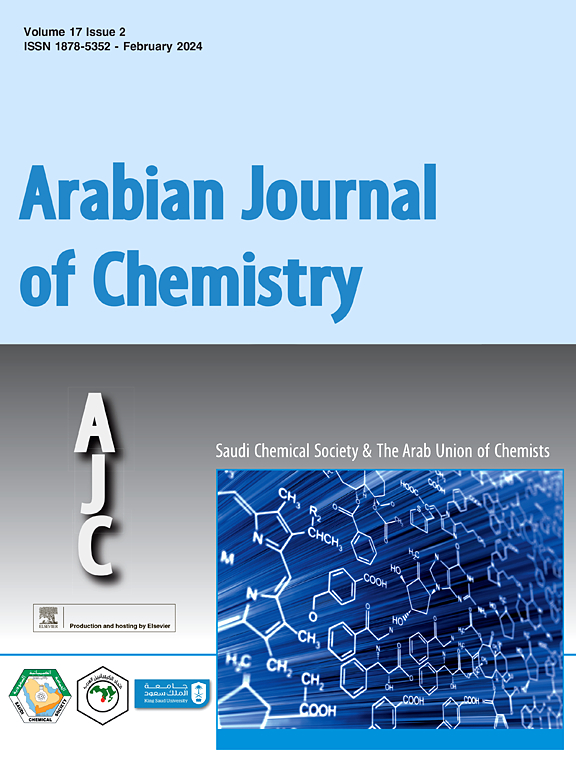Synthesis, Characterization, Antimalarial, Antimicrobial, and antioxidant activities of GNPs with Annona muricata leaf extract
IF 5.2
2区 化学
Q2 CHEMISTRY, MULTIDISCIPLINARY
引用次数: 0
Abstract
The present study is perilous to identify a quick, safe, affordable, and environmentally friendly method to synthesize nanoparticles from plant source. This is due to the extremely detrimental impacts connected to the chemical synthesis of nanoparticles. Therefore, the tropical plant species Annona muricata (A. muricata) which is a member of the Annonaceae family has numerous therapeutic applications. According to the present studies, the gold nanoparticles (GNPs) were synthesized by the green synthesis method using an aqueous extract of A. muricata. The characterizations of synthesized A. muricata-GNPs was obtained by different analytical techniques including UV–visible (UV–vis), Fourier Transformed Infrared (FTIR), Transmission Electron Microscopy (TEM), X-ray diffraction (XRD), Energy dispersive X-ray (EDX), and X-Ray Photon Spectroscopy (XPS) analysis. The successful synthesis of GNPs was identified by Surface Plasmon Resonance (SPR) peaks at 532 nm. FT-IR revealed functional groups crucial for nanoparticle formation. TEM confirmed the spherical morphology, while XRD analysis highlighted the crystalline structure. The EDX and XPS analysis determined the elemental and chemical composition of GNPs, respectively. Furthermore, A. muricata-GNPs demonstrated promising antimalarial activity against P. berghei and P. falciparum, with significant inhibition at maximum concentrations up to 4000 mg/kg. The synthesized GNPs showed significant antibacterial potentials towards both Gram-negative and Gram-positive bacterial strains by using an agar-well diffusion method which demonstrates highest level of inhibition for Pseudomonas aeruginosa (ATCC 27853). The ABTS assay was used to evaluate the antioxidant properties of GNPs that revealed maximum activity at IC50 of 96.4 µg/mL. Thus, the aim of the current study is to synthesize A. muricata-GNPs and then to explore their antimalarial, antimicrobial, and antioxidant activity that can be used as new prospects in industrial biotechnology.

番荔枝叶提取物GNPs的合成、表征、抗疟、抗菌和抗氧化活性
寻找一种快速、安全、经济、环保的植物源合成纳米颗粒的方法是当前研究的一个难点。这是由于与纳米粒子的化学合成有关的极其有害的影响。因此,番荔枝科的热带植物番荔枝(a . muricata)具有许多治疗应用。本研究采用绿色合成的方法,以田中花水提物为原料合成了金纳米颗粒。利用紫外-可见(UV-vis)、傅里叶变换红外(FTIR)、透射电子显微镜(TEM)、x射线衍射(XRD)、能量色散x射线(EDX)和x射线光子光谱(XPS)等分析技术对合成的muricata-GNPs进行了表征。通过532 nm的表面等离子体共振峰(SPR)鉴定了GNPs的成功合成。FT-IR揭示了纳米颗粒形成的关键官能团。透射电镜证实了其球形形貌,而XRD分析则强调了其晶体结构。EDX和XPS分析分别测定了GNPs的元素和化学组成。此外,muricata-GNPs对伯氏疟原虫和恶性疟原虫显示出良好的抗疟活性,最大浓度高达4000 mg/kg时具有显著的抑制作用。经琼脂孔扩散法测定,合成的GNPs对革兰氏阴性和革兰氏阳性菌株均表现出显著的抑菌活性,其中对铜绿假单胞菌(ATCC 27853)的抑菌活性最高。采用ABTS法评价GNPs的抗氧化性能,其IC50最高为96.4µg/mL。因此,本研究的目的是合成A. muricata-GNPs,并探索其抗疟、抗菌和抗氧化活性,在工业生物技术中具有新的应用前景。
本文章由计算机程序翻译,如有差异,请以英文原文为准。
求助全文
约1分钟内获得全文
求助全文
来源期刊

Arabian Journal of Chemistry
CHEMISTRY, MULTIDISCIPLINARY-
CiteScore
10.80
自引率
3.30%
发文量
763
审稿时长
63 days
期刊介绍:
The Arabian Journal of Chemistry is an English language, peer-reviewed scholarly publication in the area of chemistry. The Arabian Journal of Chemistry publishes original papers, reviews and short reports on, but not limited to: inorganic, physical, organic, analytical and biochemistry.
The Arabian Journal of Chemistry is issued by the Arab Union of Chemists and is published by King Saud University together with the Saudi Chemical Society in collaboration with Elsevier and is edited by an international group of eminent researchers.
 求助内容:
求助内容: 应助结果提醒方式:
应助结果提醒方式:


